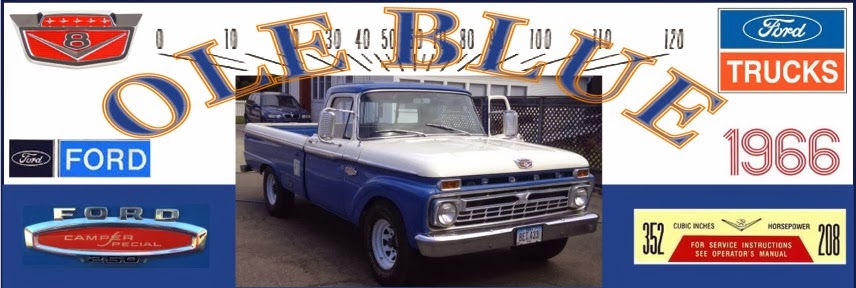After many days of procrastination, I finally went down to Napa and bought a gasket to mount the rebuilt carburetor Uncle Ken had sent out. I was a little worried that this was a primary component I was thinking of messing with and was not sure if I could successfully tear Old Blue apart and get her running again. Even though the old carburetor made for a very active driving experience; pulling out the choke when coming to a stop or turning a corner, pumping the gas pedal religiously before trying to start her up, OH Yeah! and pressing down HARD on the brake pedal at any stop as the idle speed was set at about 1300 RPM's to keep her engine running while idling I know all to well that a working Truck is worth 20 sitting in the garage... It was with this trepidation that I made the trip across town in Old Blue to get the final parts and supplies I would need for the task at hand.
The old carburetor was a very simple affair with no vacuum advance, manual choke and a weird little connection to the transmission to down shift when the driver stepped down hard on the accelerator.
I bought the gasket and some gasket 'glue' and read up on the procedure, more than a little wary of the potential for vacuum leaks and even dropping screws down into the guts of Old Blue's 352 -- AAACCCKKK was this going to be some kind of brain surgery??
As it turns out the procedure was fairly straight forward and took about 1/2 an hour! I had spent about a month reading about various replacement procedures all over the web. The 2100 series 2V Auto-Lite/Motorcraft Carburetor is sooo well known and a staple for many cars (mine is marked C5TF C) so lots and lots of people have written about how to rebuild them and mount them on various engines.
 |
| C5TF C AutoLite 2V |
I noticed a few things about Old Blues setup. First, as mentioned, she had NO vacuum advance connections on the carburetor which meant that there was no changes to her timing at idle, at acceleration or at freeway cruising. Second, Her idle speed was set almost as high as it would go.Third, she still had her original fuel intake setup as a straight metal pipe from the fuel pump down under the oil filter straight into the front of the carburetor - not many 352's still have this from the pictures I have seen.
Before swapping the carburetors, I set the idle mixture screws on the rebuilt one to 1.5 turns OUT for each port.
I followed the simplest of procedures hoping to minimize any potential complexity:
1. Take pictures of 'current' setup in case I mess something up
2. Pull air cleaner
3. Pull accelerator cable
4. Pull transmission step down shaft
5. Pull choke cable
6. Pull fuel line
7. Unscrew 4 bolts holding carburetor to input manifold
8. Set both idle mixture screws on replacement to 1.5 turns out
9. Clean seat of old gasket (there was none since carburetor came off clean
10. slop gasket glue on new gasket and seat
11. Mount rebuilt carburetor and bolt down
12. Reconnect Fuel, choke, accelerator and transmission points
13. Put on Air Cleaner
14. Try to start!
While I had the air cleaner off, I cleaned it up with a little chrome polish and painted the screw 'old ford blue'.
After bolting down the carburetor to the spacer with the new gasket I reconnected the accelerator, choke and fuel line - setting the idle adjustment screw to where it just touched the stop plate, essentially letting her idle at the lowest capable.
It took a few minutes to figure out how to adjust the choke so that the fast cold idle screw hit the plate just right but not too weird at all - simple mechanical parts - very cool.
Now for the fateful test ... try to start her up.
Some Additional Information from Bill at the FE forum:1. The newer number is: C9UZ9510AA (Motorcraft CA698) / Obsolete
2. The Autolite/Motorcraft 2V carb is essentially the same as used on 1962/74 F100/350's and Passenger Cars.
3. Manual chokes were used on all 1962/66 F100/350's (some 1967/68's). The 1970/74 version has a choke pull-off diaphram mounted on the air horn.
4. The carb kit is the same for all of them: D4AZ9A586A [replaced C2AZ9A586B] (Motorcraft CT499D).
5. T/E = Thermactor Emission (smog pump) was first installed in F100's and Passenger Cars after 1/1/1966 in vehicles sold new in CA.
6. 1965/66 F100/350 352 MX C-O-M carb jets: 51F = 0-5,000 ft // 49F = 5,000-10,000 ft // 47F = 10,000-15,000 ft.
[ this document describes how to replace Autolite 2100 2v on a 1966 Ford F-250 w/352 V8 ]


































